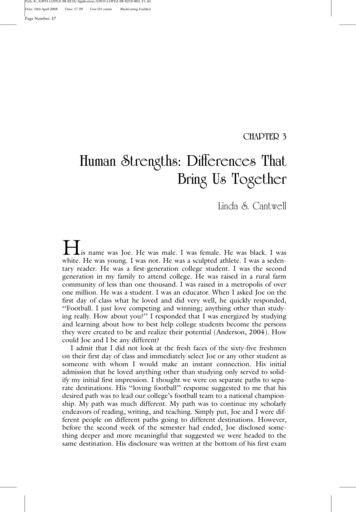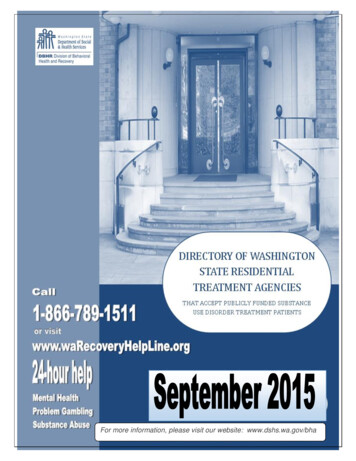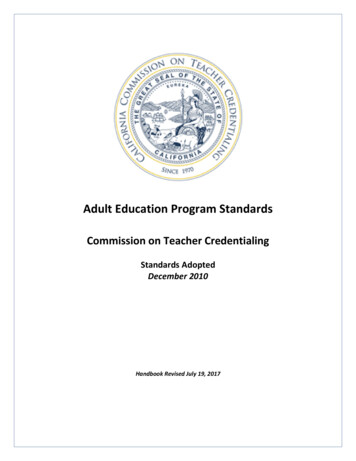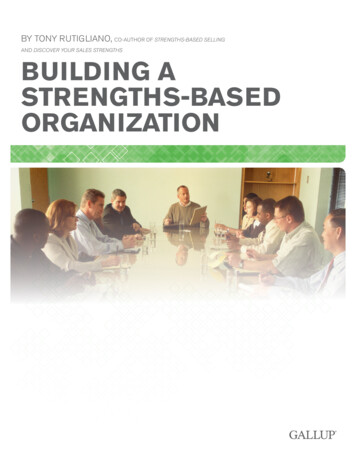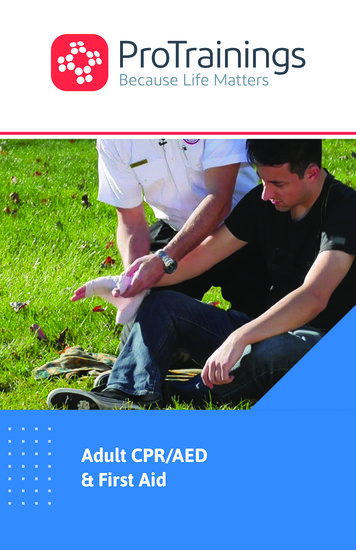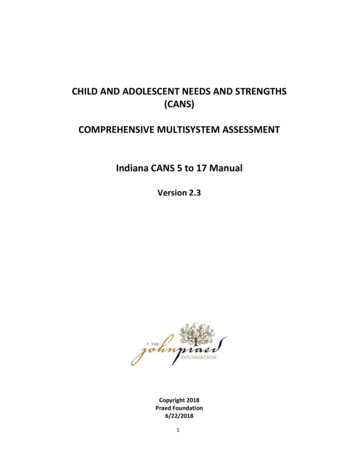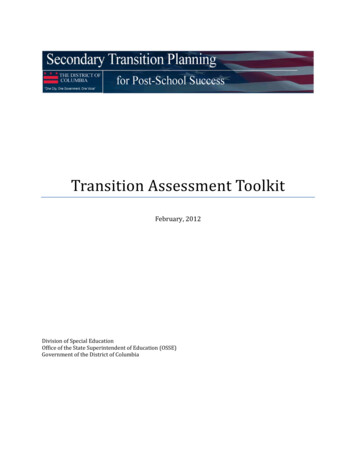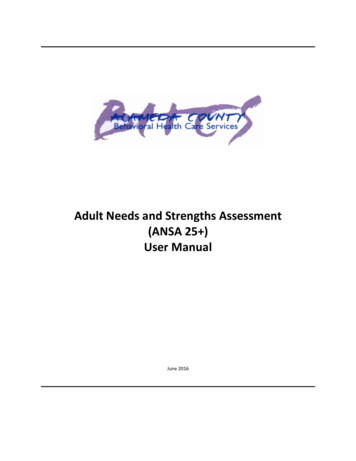
Transcription
Adult Needs and Strengths Assessment(ANSA 25 )User ManualJune 20161
A large number of individuals have collaborated in the development of the ANSA. Along with theANSA, versions for developmental disabilities, juvenile justice, and child welfare, this informationintegration tool is designed to support individual case planning and the planning and evaluationof service systems. The ANSA-Comprehensive is an open domain tool for use in service deliverysystems that address the mental health of young adults and their families. The copyright is heldby the Praed Foundation to ensure that it remains free to use. For specific permission to useplease contact the Foundation. For more information on the ANSA-Comprehensive assessmenttool contact:John S. Lyons, Ph.D.Chapin Hall at the University of Chicago1313 East 60th StreetChicago, IL 60637jlyons@chapinhall.orgThe Praed Foundation550 N. Kingsbury Street, #101Chicago, IL orgAlexander Jackson, LCSWDirector, Special ProjectsAlameda County Behavioral Health Care Services2000 Embarcadero Cove, Suite 400Oakland, CA 94606ajackson@acbhcs.org2
Table of ContentsIntroduction to the Adult Needs and Strengths Assessment (ANSA) . iSix Key Principles of a Communimetric Tool . iiRating Needs and Strengths . iiiThe basic design for rating NEEDS . iiiThe basic design for rating STRENGTHS . iiiHow is the ANSA Used? . vIt is an Assessment Strategy . vIt Guides Care and Treatment Planning. vIt Establishes Medical Necessity . vIt Facilitates Outcomes Measurement . vIt is a Communication Tool . vANSA as a Mental Health Strategy . viMaking the best use of the ANSA . viListening using the ANSA . viRedirect the conversation to parents’/caregivers’ own feelings and observations . viiAcknowledge Feelings . viiWrapping it Up . viiPotentially Traumatic/Adverse Childhood Experiences . 1Life Functioning Domain . 6Strengths. 13Cultural Factors . 18Behavioral Health Needs . 21Risk Behaviors . 27Caregiver Resources and Needs Domain (Optional Section). 31Health Module (1) . 35Vocational and Career Needs Module (2) . 37Developmental Needs Module (3) . 39Parenting/Caregiving Role Module (4) . 40Substance Abuse Module (5) . 42Traumatic Stress Symptoms Module (6) . 44Suicide Risk Module (7) . 48Dangerousness Module (8) . 50Crime Module (9) . 54Appendix A: Suggested Older Adult Readings . 57Appendix B: ANSA Rating Sheet . 583
Introduction to the Adult Needs and Strengths Assessment (ANSA)The Adult Needs and Strengths Assessment (ANSA) is a multi-purpose tool developed to support careplanning and level of care decision-making, to facilitate quality improvement initiatives, and to allow forthe monitoring of outcomes of services. The ANSA was developed from a communication perspective inorder to facilitate the linkage between the assessment process and the design of individualized serviceplans including the application of evidence-based practices.ANSA gathers information on clients’ needs and strengths. Strengths are areas of an individual’s life wherehe or she is doing well or has an interest or ability. Needs are areas where an individual requires help orserious intervention. Service providers in Alameda County use an assessment process to get to know theindividuals and families with whom they work and to understand their strengths and needs. The ANSA canhelp providers decide which of an individual’s needs are the most important to address in a treatmentplan. The ANSA also helps identify strengths, which can be the basis of a treatment plan. By working withthe client and family closely during the assessment process and talking together about the ANSA,providers can develop a treatment plan that addresses an individual’s strengths and needs while buildingstrong engagement.The ANSA is made of domains that focus on an area in the individual’s life. Each section is made up of agroup of specific items. There are sections on how individuals’ function in everyday life, on specificemotional or behavioral concerns, on risk behaviors, on strengths and on skills needed in adult life. Whenpossible, there is also a section that asks about the family’s beliefs and preferences, and a section thatasks about general family concerns. The provider gives a number rating to each of these items. Theseratings help the provider understand where intensive or immediate action is most needed, and also wherean individual has strengths that could be a major part of the treatment plan.Of course, ratings do not tell the whole story of an individual’s strengths and needs. Each ANSA section ismerely the output of a comprehensive assessment process and is documented alongside narratives wherea provider can give more information about that area of life. The provider can note questions that needto be explored further, or areas where people involved with the individual have different ideas about theindividual.i
Six Key Principles of a Communimetric ToolThe ANSA has six key principles that, when applied, make the assessment process move more smoothly.1. Items impact service planning. An item exists because it helps in identifying needs for thetreatment plan.2. Items ratings translate into Action Levels. An item rated 2 or 3 requires action.3. Consider culture and development. Culture and development must be considered beforeestablishing the action level for each item.4. Agnostic as to etiology. It is descriptive tool. Rate the “what” and not the “why”. The ANSAdescribes what is happening with the individual, but does not seek to assign a cause for a behavioror situation.5. It’s about the individual, not the service. Don’t rate behavior with a low score if the individualhas been in a controlled environment. If an intervention is present that is masking a need butmust stay in place, it is factored into the rating and would result in a rating of an actionable need(i.e., 2 or 3).6. Specific ratings window (e.g. 30 days) can be over-ridden based on action levels. Keep theinformation fresh and RELEVANT. Don’t get stuck on 30 days – if the need is relevant and olderthan 30 days, still use the information. Action Levels supersede Time Frames – if the item shouldbe on your treatment plan, rate it higher!ii
Rating Needs and StrengthsThe ANSA is easy to learn and is well liked by young adults and families, providers and other partners inthe services system because it is easy to understand and does not necessarily require scoring in order tobe meaningful to the individual and family. Basic core items – grouped by domain - are rated for all individuals.A rating of 1, 2 or 3 on key core questions triggers extension modules.A few additional questions are required for the decision models to function.Each rating level on the ANSA suggests different pathways for service planning. There are four levels ofeach item with anchored definitions; however, these definitions are designed to translate into thefollowing action levels (separate for needs and strengths):The basic design for rating NEEDSRating0Level of NeedNo evidence of need.Appropriate ActionNo action needed.1Significant history or possible need that isnot interfering with functioning.Watchful waiting / prevention / additionalassessment.2Need interferes with functioning.Action / Intervention required3Need is dangerous or disabling.Immediate action / Intensive actionrequiredThe basic design for rating STRENGTHSRating0Level of StrengthCenterpiece strength.Appropriate ActionCentral to planning.1Strength present.Useful in planning.2Identified strength.Build or develop strength.3No strength identifiedStrength creation or identification may beindicatedThe rating of NA or not applicable should be used with cases in the rare instances where an item does notapply to that particular client. NA is available for a few items under specified circumstances (see manualdescriptions).The ANSA is an effective information integration tool for use in the development of individual plans ofcare, to monitor outcomes, and to help design and plan systems of care for adults and older adults withbehavioral health (mental health or substance use) challenges.To administer the ANSA, the care provider should read the anchor descriptions for each item (ordimension) and then record the appropriate rating on the ANSA assessment form or electronic entrysystem. This should be done after gathering relevant information, including talking with the individualand other important people in the individual’s life.iii
Remember that the item anchor coding descriptions are examples of circumstances which fit each rating(0, 1, 2, or 3). The descriptions are not inclusive. Sometimes the rating must consider the best meaningof each rating level to determine the appropriate rating on an item (or dimension) for an individual.Ratings of 1, 2 or 3 on key core items trigger additional questions in extension modules: Vocational/Career,Developmental Needs, Parenting/Caregiving Role, Trauma/Adjustment to Trauma, Substance Use,Suicide Risk, Dangerousness, Sexually Aggressive Behavior, Crime, and Health.Decision support applications include the development of specific algorithms for levels of care includingtreatment foster care, residential treatment, intensive community services, supportive, and traditionaloutpatient care. Algorithms can be localized for sensitivity to varying service delivery systems andcultures.In terms of quality improvement activities, a number of settings have utilized a fidelity model approachto look at service/treatment/action planning based on the ANSA assessment. A rating of ‘2’ or ‘3’ on anANSA need suggests that this area must be addressed in the plan. A rating of a ‘0’ or ‘1’ identifies a strengththat can be used for strength-based planning and a ‘2’ or ‘3’ a strength that should be the focus onstrength-building activities.Finally, the ANSA can be used to monitor outcomes. This can be accomplished in two ways. First, itemsthat are initially rated a ‘2’ or ‘3’ are monitored over time to determine the percent of individuals whomove to a rating of ‘0’ or ‘1’ (resolved need, built strength). Or, domain scores can be generated bysumming items within each of the domain (Behavioral Health Needs, Risk Behaviors, Life Functioning,etc.). These scores can be compared over the course of treatment. ANSA dimension (domain) scores havebeen shown to be valid outcome measures in residential treatment, intensive community treatment, andcommunity mental health.The ANSA has demonstrated reliability and validity. With training, any one with a bachelor’s degree canlearn to complete the tool reliably, although some applications require a higher degree. The averagereliability of the CANS is 0.78 with vignettes across a sample of more than 80,000 trainees. Thereliability is higher (0.84) with case records, and can be above 0.90 with live cases (Lyons, 2009). TheCANS is auditable and audit reliabilities demonstrate that the CANS is reliable at the item level.The ANSA is an open domain tool that is free for anyone to use. There is a community of people who usethe various versions of the ANSA and share experiences and additional items and supplementary tools.ReferenceLyons, J.S (2009). Communimetrics: A communication theory of measurement in human service settings.New York: Springer.iv
How is the ANSA Used?In Alameda County, we use the ANSA in many ways to transform the lives of adults, older adults andtheir families and to improve our programs. This guide is intended to support your use of the ANSA-asa multi-purpose tool. What is the ANSA?It is an Assessment StrategyWhen you first meet your clients and their caretakers, you can use this guide to make sure you gatherall the information you need. Most items include “Questions to Consider” which you may find usefulin when asking about needs and strengths. These are not questions that you must ask, but are availableto you as suggestions. Many care providers have found this useful to use during initial sessions eitherin person or over the phone if there are follow up sessions required to get a full picture of needs beforebeginning therapy and treatment planning.It Guides Care and Treatment PlanningWhen we mark an item on the ANSA as a ‘2’ or ‘3’ (‘action needed’ or ‘immediate action needed’) weare indicating not only that it is a serious need for our client, but one that we are going to attempt towork on during the course of our treatment. As such, when you write your treatment plan, you shoulddo your best to address any Needs, Impacts on Functioning, or Risk factors that you rate as a 2 or higherin that document.It Establishes Medical NecessityFor many insurance plans, including services billed to Medicare/Medi-Cal, it is important that weestablish that the work we do is medically necessary. We may know that it is, but it also needs to bereflected in documentation tools like the ANSA. Individuals who have been referred to us for servicegenerally have at least one score of ‘2’or ‘3’ in both their Needs and Impact and Functioning areas.Although you do not need to score the ANSA in any particular way, a low enough score would indicatethat our client might not really need our services. The scores we give on the ANSA can guide us inchoosing the best diagnosis, the best level of care or intensity of supports, and the most critical areaswhere individuals may need our support and crisis interventions.It Facilitates Outcomes MeasurementMany users of the ANSA and organizations complete the ANSA every six months to measure change andtransformation. We work with individual and families and their needs tend to change over time. Needsmay change in response to many factors including quality clinical support provided. One way wedetermine how our supports are helping to alleviate suffering and restore functioning is by re-assessingneeds and tracking change.It is a Communication ToolWhen a client leaves one of our programs, we may do a closing ANSA to define progress, measureongoing needs and help us make continuity of care decisions. Doing a closing ANSA, much like adischarge summary integrated with ANSA scoring, gives us a picture of how much progress has beenmade, and allows us to make recommendations for future care which tie to current needs. And finally,it gives us a shared language to talk about our clients and creates opportunities for collaboration. It isour hope that this guide will help you to make the most out of the ANSA and guide you in filling it outin an accurate way that helps you make good clinical decisions.v
ANSA as a Mental Health StrategyThe ANSA is organized into parts: You can start with any of the sections—Life Domain Functioning orBehavioral Health Needs, Risk Behaviors or Strengths—this is your judgment call. Sometimes, peopleneed to talk about needs before they can acknowledge strengths. Sometimes, after talking aboutstrengths, then they can better explain the needs. Trust your judgment, and when in doubt, always ask—“ we can start by talking about what you feel that you need, or we can start by talking about the thingsthat are going well and that you want to build on. Do you have a preference?”It also is a good idea to become familiar with the ANSA. The ANSA was designed to be the output of anassessment process and was not intended to be an interview tool or a paper-and-pencil measure.Integrating the ANSA into your current assessment process will be the most natural. Conducting yourassessment as a conversation is also more likely to give you good information, so have a general idea ofthe items.Also, some people may “take off” on a topic. The great thing about the ANSA is that you can follow theirlead. So, if they are talking about anger control and then shift into something like---“you know, he onlygets angry when he is in Mr. S’s classroom”, you can follow that and ask some questions about situationalanger. So that you are not searching and flipping through papers, have some idea of what page that itemis on.Making the best use of the ANSAWhen adults or older adults have families involved in their lives, their family can be a great asset to theindividual’s treatment. To increase family involvement and understanding, describe to the family theassessment process, the ANSA and how you will be using the tool. The best time to do this is yourdecision—you will have a sense of the timing as you work with each family. Families often feel respectedas partners when they are prepared for a meeting or a process. A copy of the completed ANSA should beoffered to each family, and they should always be encouraged to discuss the ratings with you and/or thetreatment team.Listening using the ANSAListening is the most important skill that you bring to the ANSA. Everyone has an individual style oflistening. The better you are at listening, the better the information you will receive. Some things to keepin mind that make you a better listener and that will give you the best information: Use nonverbal and minimal verbal prompts. Head nodding, smiling and brief “yes”, “and”—things that encourage people to continue Be nonjudgmental and avoid giving person advice. You may find yourself thinking “if I were thisperson, I would do X” or “that’s just like my situation, and I did “X”. But since you are not thatperson, what you would do is not particularly relevant. Avoid making judgmental statements ortelling them what you would do. It’s not really about you. Be empathic. Empathy is being warm and supportive. It is the understanding of another personfrom their point of reference and acknowledging feelings. You demonstrate empathetic listeningwhen you smile, nod, maintain eye contact. You also demonstrate empathetic listening when youfollow the person’s lead and acknowledge when something may be difficult, or when somethingis great. You demonstrate empathy when you summarize information correctly. All of thisdemonstrates to the individual that you are with him/her.vi
Be comfortable with silence. Some people need a little time to get their thoughts together.Sometimes, they struggle with finding the right words. Maybe they are deciding how they wantto respond to a question. If you are concerned that the silence means something else, you canalways ask “does that make sense to you”? “Or do you need me to explain that in another way”? Paraphrase and clarify—avoid interpreting. Interpretation is when you go beyond theinformation given and infer something—in a person’s unconscious motivations, personality, etc.The ANSA is not a tool to come up with causes. Instead, it identifies things that need to be actedupon. Rather than talk about causation, focus on paraphrasing and clarifying. Paraphrasing isrestating a message very clearly in a different form, using different words. A paraphrase helpsyou to (1) find out if you really have understood an answer; (2) clarify what was said, sometimesmaking things clearer; (3) demonstrate empathy. For example, you ask the questions abouthealth, and the person you are talking to gives a long description. You paraphrase by saying “Ok,it sounds like is that right? Would you say that is something that you feel needs to bewatched, or is help needed?”Redirect the conversation to parents’/caregivers’ own feelings and observationsOften, people will make comments about other people’s observations such as “well, my mother thinksthat his behavior is really obnoxious.” It is important to redirect people to talk about their observations:“so your mother feels that when he does X, that is obnoxious. What do YOU think?” The ANSA is a toolto organize all points of observation, but the adult client’s perspective is the most important at the timewhen you are doing the assessment. Once you have his/her perspective, you can then work on organizingand coalescing the other points of view. In addition, the statements made by others can be noted in thecomments section.Acknowledge FeelingsPeople will be talking about difficult things and it is important to acknowledge that. Simpleacknowledgement such as “I hear you saying that it can be difficult when.” demonstrates empathy.Wrapping it UpAt the end of the assessment process, we recommend the use of two open-ended questions. Thesequestions ask if there are any past experiences that people want to share that might be of benefit toplanning for their young adult, and if there is anything that they would like to add. This is a good time tosee if there is anything “left over”—feelings or thoughts that they would like to share with you.Take time to summarize with the individual and family those areas of strengths and of needs. Help themto get a “total picture” of the individual and family, and offer them the opportunity to change any ratingsas you summarize or give them the “total picture”.Take a few minutes to talk about what the next steps will be. Now you have information organized into aframework that moves into the next stage—planning.So you might close with a statement such as: “OK, now the next step is a “brainstorm” where we takethis information that we’ve organized and start writing a plan—it is now much clearer which needs mustbe met and what we can build on. So let’s start ”vii
Potentially Traumatic/Adverse Childhood ExperiencesAll of the Potentially Traumatic/Adverse Childhood Experience items are static indicators. In other words,these items indicate whether or not an individual experienced the particular trauma. If he/she has everhad one of these experiences it would always be rated in this section, even if the experience were notcurrently causing problems or distress in the individual’s life. Thus these items are not expected tochange except in the case that the individual has a new trauma experience or a historical trauma isidentified that was not previously known.These ratings are made based on LIFETIME exposure of trauma or adverse childhood experiences. Thefollowing categories and action levels are used:0 No evidence of any trauma of this type.1 A single incident of trauma occurred, or suspicion exists of this trauma type.2 The individual has experienced multiple incidents or moderate degree of this trauma type.3 Repeated and severe incidents of trauma with medical/physical consequences.Question to Consider for this Domain: Has the Individual experienced adverse life events that may impacthis/her behavior? Please rate within the Individual’s lifetime.SEXUAL ABUSE - This item rates the severity and frequency of sexual abuse.Questions to ConsiderRatings & Definitions Has the caregiver or Individualdisclosed sexual abuse?0There is no evidence that Individual has experienced sexual abuse. How often did the abuse occur?1 What was the Individual’srelationship to the perpetrator?Individual has experienced one episode of sexual abuse or there is a suspicionthat Individual has experienced sexual abuse but no confirming evidence.2Individual has experienced repeated sexual abuse. Did the abuse result in physicalinjury?3Individual has experienced severe and repeated sexual abuse.PHYSICAL ABUSE - This item rates the severity and frequency of experiences of physical abuse.Questions to ConsiderRatings & DefinitionsHas the individual or caregiverdisclosed a history of physicalabuse?0There is no evidence that individual has experienced physical abuse.1Individual has experienced one episode of physical abuse or there is a suspicionthat individual has experienced physical abuse but no confirming evidence. Is physical discipline used in thehome? What forms?2Individual has experienced repeated physical abuse. Has the individual every receivedbruises, marks, or injury fromphysical discipline? 3Individual has experienced severe and repeated physical abuse that causessufficient physical harm to necessitate hospital treatment.1
NEGLECT - This rating describes the degree of severity of neglect an individual has experienced. Neglect can refer to alack of food, shelter or supervision (physical neglect) or lack of access to needed medical care (medical neglect), orfailure to receive an academic instruction (educational neglect).Questions to ConsiderRatings & Definitions Is the individual getting adequatesupervision?0There is no evidence that individual has experienced neglect. Are the individual’s basic needs forfood and shelter being met?1Individual has experienced minor occasional neglect. Individual may have beenleft home alone for a short period of time with no adult supervision or theremay be occasional failure to provide adequate supervision of individual Is the individual allowed access tonecessary medical care bycaregivers?2Individual has experienced a moderate level of neglect. Individual may havebeen left home alone overnight or there may be occasional failure to provideadequate food, shelter, or clothing with corrective action.Do the caregivers prevent theindividual from accessingeducation?3Individual has experienced a severe level of neglect including multiple and/orprolonged absences by adults, with minimal supervision, and failure to providebasic necessities of life on a regular basis. EMOTIONAL ABUSE - This item rates the severity and intensity of experiences of emotional abuse, including belittling,shaming, and humiliating an individual, calling names, making negative comparisons to others, or telling an individualthat he or she is, “no good.”Questions to Consider How does the caregiver talk to/interact with the individual? Is there name calling or shaming inthe home?Ratings & Definitions0There is no evidence that individual has experienced emotional abuse.1Individual has experienced mild emotional abuse.2Individual has experienced emotional abuse over an extended period of time(at least one year).3Individual has experienced severe and repeated emotional abuse over anextended period of time (at least one year).MEDICAL TRAUMA - This item rates the severity of medically related trauma, including inpatient hospitalizations,outpatient procedures, and significant injuries.Questions to Consider Has the individual broken anybones? Has the individual had to go to theemergency room or stay overnightin the hospital?Ratings & Definitions0There is no evidence that individual has experienced any medical trauma.1Individual has experienced mild medical trauma including minor surgery (e.g.stitches, bone setting).2Individual has experienced moderate medical trauma including major surgeryor injuri
an individual has strengths that could be a major part of the treatment plan. Of course, ratings do not tell the whole story of an individuals strengths and needs. Each ANSA section is merely the output of a comprehensive assessment process and is documented alongside narratives where a pr
